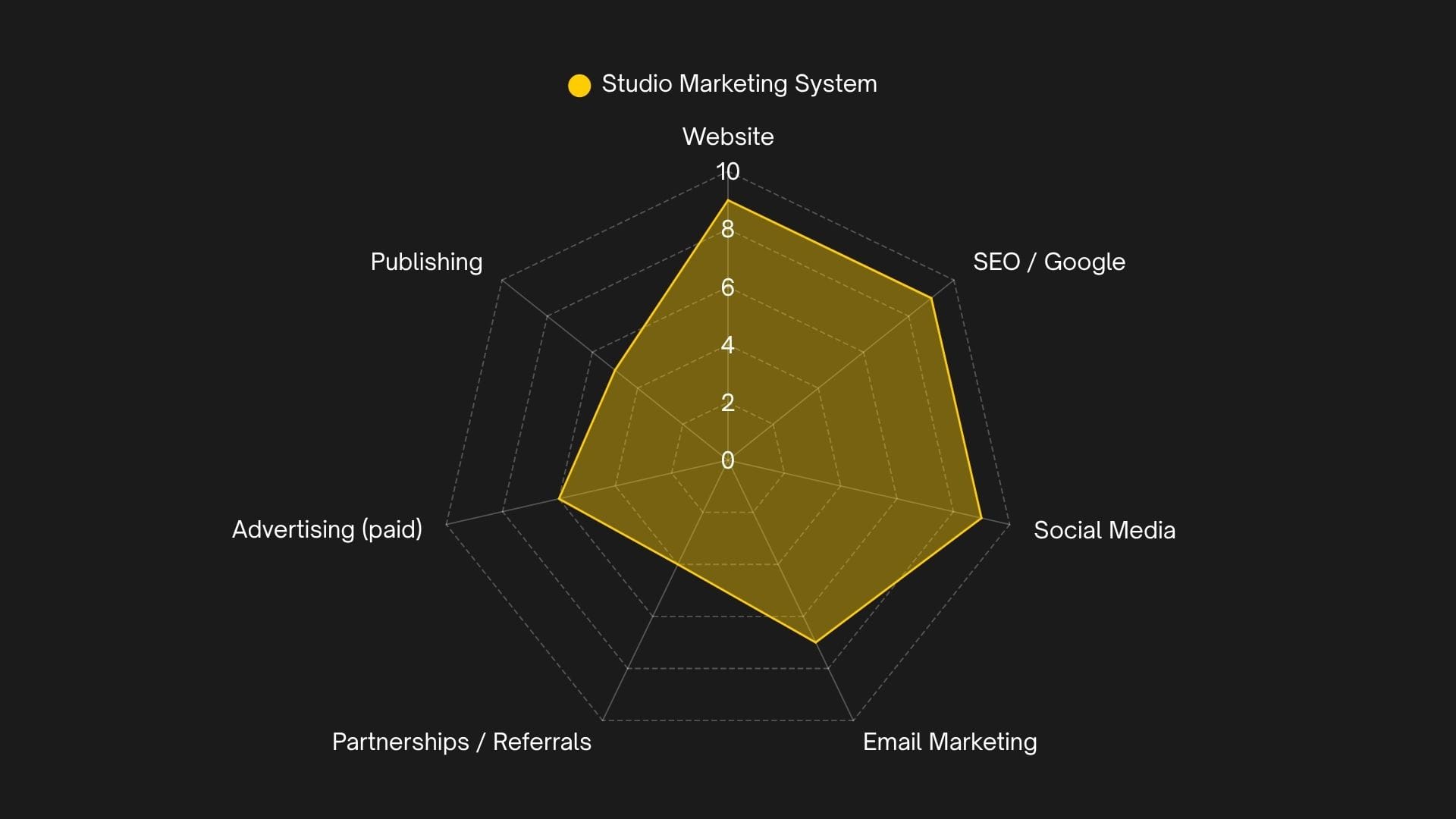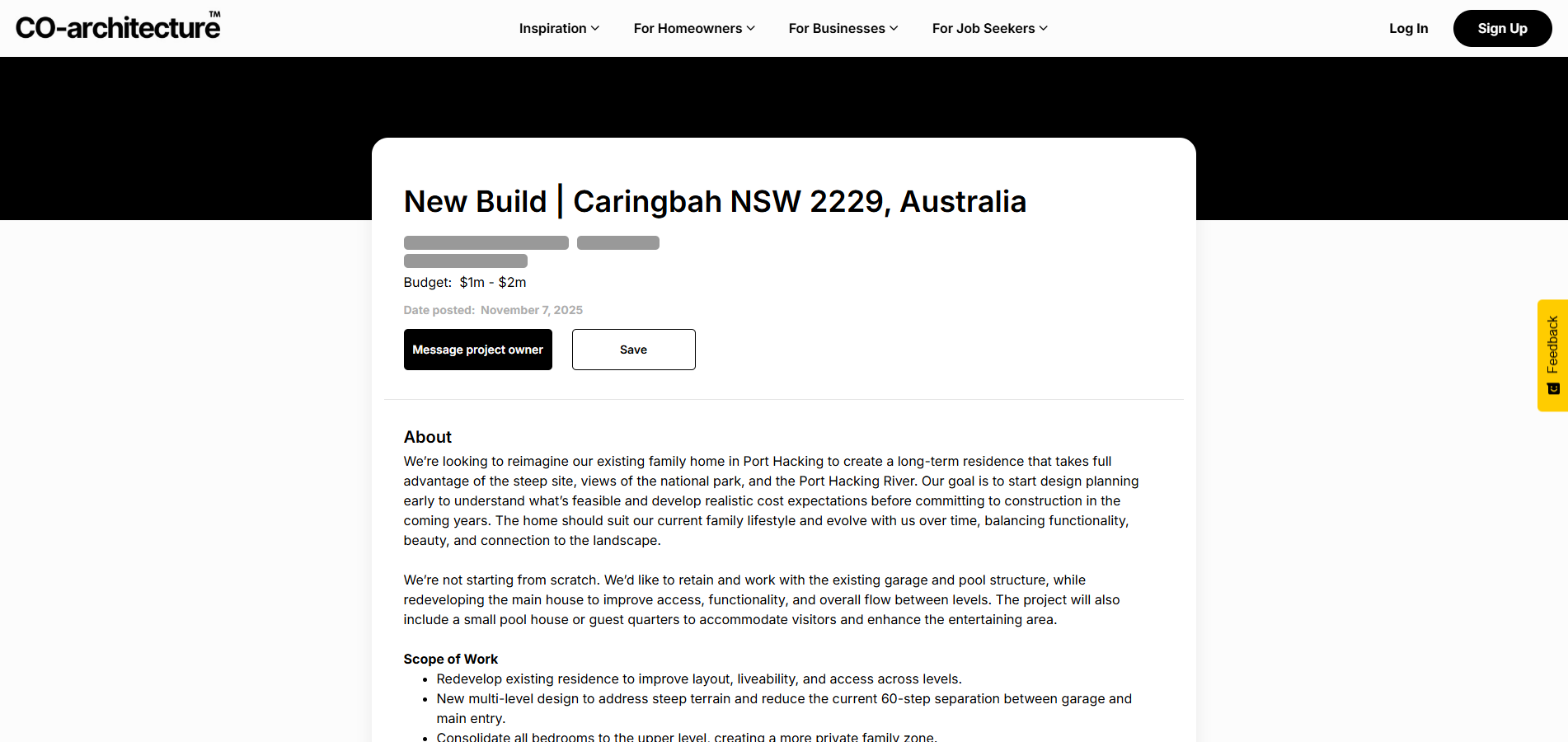This guide is designed to help you get the most out of the CO-architecture Project Portal feature: how it works, how to respond in a way that feels clear and respectful to homeowners, and how small changes to your first contact can significantly improve engagement and your chances of being selected.
It’s important to recognise that CO-architecture is just one part of a broader marketing strategy and system. Project leads will work best when they sit alongside a solid foundation - a current website, active social channels, a clear portfolio, and well-communicated capabilities. If these elements are weak or out of date, even strong leads will be harder to convert.

At this stage, the Project Portal feature is designed as a lead funnel - it connects you with interested homeowners, but it does not replace the work of converting those enquiries into projects. It can be frustrating when you don’t receive a reply, and yes, there are factors outside your control: some homeowners aren’t fully ready, some contact multiple studios at once, and some simply get busy and drop the ball.

However, the reality is that your response plays a decisive role. How quickly you reply, how clearly you communicate, how approachable you sound, and whether you offer a simple next step all have a direct impact on whether a homeowner chooses to engage with you. This guide focuses on those parts - the areas where studios can do better - to turn more leads into real, billable work.
1) How the Project Portal Works
When a homeowner first contacts CO-architecture about a project, we don’t send that straight to studios.
Our team books a short 30-minute call with the homeowner to:
- Clarify their goals and scope
- Talk through timing, constraints and priorities
- Sense-check their scope and expectations
- Help them shape a clear, written brief
Once the brief is clear, the project is then posted on the Project Portal and from there, it’s over to you.
CO-architecture connects you with homeowners who have already had an initial conversation and a shaped brief. It does not guarantee a response or a project. Your results will depend heavily on how you handle that first contact and what you do next.

2. What “good” looks like: core principles
Studios that consistently convert leads tend to do the same few things well:
- Respond quickly
Within 24–48 hours. If you’re taking a week to reply, you’re probably already behind another studio. - Keep it short and focused on the homeowner
4-6 clear sentences, not a wall of text about your awards. - Show you’ve read the brief
Reference their project type, suburb, and budget. Generic emails feel like spam and get ignored. - Offer a simple next step
Usually: a short call, or a couple of clear questions. Don’t make them figure out what to do. - Sound human and approachable
Homeowners often haven’t worked with a design professional before. They need reassurance, not jargon.
If your current responses don’t tick these boxes, improving them is the fastest way to get better results.
3. Recommended contact flow
A simple, respectful contact flow looks like this:
Step 1 - Start with a tailored email
Your first touch should be email, not a cold call.
- Acknowledge the CO-architecture brief
- Reference specific details (project type, area, budget)
- Suggest one clear next step (usually a short call)
- Give 1–2 time options or ask for their availability
*If you don't get a reply by email, it is good practice to follow up with a phone call to confirm they recieved it within 24hrs.
Step 2 - Book a short call (if they’re interested)
Once they reply:
- Confirm a 10–20 minute call
- Use it to:
- Clarify scope and priorities
- Test budget vs reality
- See if there’s a good fit both ways
Step 3 - Follow up with a recap email
After the call:
- Summarise what you heard
- Confirm agreed next steps and timelines
- Outline what you will send (fee proposal, example projects, etc.)
This flow is simple, respectful and familiar to most clients - and it gives you multiple chances to demonstrate professionalism.
4. Writing a stronger first response
Do:
- Reply within 24–48 hours
- Use a clear subject line:
“Your CO-architecture project - [Suburb/Type]” - Open with: “Thanks for posting your project on CO-architecture…”
- Mention at least two specifics (e.g. renovation in Brunswick, $600–800k budget).
- Offer one clear next step.
Don’t:
- Paste in 3–4 paragraphs about your history, awards and philosophy.
- Send a fee proposal immediately with no conversation.
- Use stiff, formal language that sounds like a contract.
- Leave it vague: “Let us know if you’re interested.” (They won’t.)
5. Example email templates
Template 1 - Initial response + offer of a call
Subject: Your CO-architecture project – [Project type in suburb]
Hi [Client Name],
Thanks for posting your project on CO-architecture. I’ve read through your brief for [project type] in [suburb/area] with a budget of [budget range], and it’s very much aligned with the kind of work we do.
We’d be happy to talk through what’s possible with your budget and outline how we typically approach projects like this.
Would you be open to a quick 15–20 minute call next week? I’m available [day/time] or [day/time], but happy to work around you.
Warm regards,
[Name]
[Role]
[Studio]
[Website / Phone]
Template 2 - Clarifying questions first
Subject: Re: Your project on CO-architecture
Hi [Client Name],
Thank you for sharing your project on CO-architecture. Your brief for [renovation / new build / interiors] in [suburb] sounds like a great opportunity to [e.g. rework the layout, bring in more light, improve performance].
To understand whether we’re a good fit and give you meaningful next steps, could you let us know:
- Whether you already have any existing plans or documentation
- Your ideal timing for starting and completing the project
- How fixed the budget range you’ve listed is
Once we have a little more detail, we can suggest a suitable way forward and outline the process.
Kind regards,
[Name]
[Studio]
Template 3 - Follow-up after a call
Subject: Next steps – your CO-architecture project
Hi [Client Name],
Thanks again for taking the time to speak with me about your project in [suburb/area]. It was helpful to understand more about your priorities around [e.g. light, space, sustainability, family needs].
As discussed, our next step will be to [prepare a fee proposal / send through similar project examples / outline a suggested process and timeline], which I’ll share with you by [day/date].
If any other questions come up in the meantime, feel free to reply to this email.
Warm regards,
[Name]
[Studio]
6. Following up (without being annoying)
Silence doesn’t always mean “no” - sometimes it means “I’m busy” or “I forgot”.
A simple follow-up is fine:
- Wait 1–2 days after your first email
- Send one short follow-up
- If they still don’t respond, move on
Example:
Hi [Client Name],
Just a quick follow-up on your project posted via CO-architecture. No pressure at all, but if you’re still exploring studios for [project type in suburb], we’d be happy to have a brief chat about options and next steps.
If you’ve already started working with someone, feel free to let us know so we can close this off on our end.
Best,
[Name]
7. Budget, scope and realistic expectations
A common reason homeowners go quiet is that they’re unsure whether their budget and scope match. This is where clear, honest communication matters.
Your responsibility as a studio:
- Treat the listed budget as a starting point for discussion, not a fixed rule.
- If the scope and budget don’t align, say so clearly and offer guidance.
- Where appropriate, suggest:
- Reduced scope
- Staging the work
- A realistic budget range based on your experience
Example wording:
“Based on projects of a similar type and scale, we typically see total project budgets in the range of [X–Y]. We’d be happy to talk through what’s achievable at different levels and how to get the best value from your investment.”
8. Improving your studio’s overall conversion environment
Even with strong responses, if your external presence is weak, homeowners may hesitate.
A homeowner will often:
- See your email
- Open your website / Instagram
- Decide whether you “feel right”
Make sure those touchpoints don’t let you down:
- Website: clear, current, easy to navigate, shows recent projects
- Socials: not dead; a few recent posts is enough
- Portfolio: good imagery, a sense of scale and budget
- Positioning: clearly state what you do and typical project types/budgets
CO-architecture can send you leads - but if your broader presence doesn’t back up your email, conversion will always be harder.
9. Quick checklist for studios
- Are we replying within 24–48 hours?
- Is our first email short, specific and approachable?
- Do we offer a clear next step (call / questions)?
- Are we sending one follow-up after a few days?
- Is our CO-architecture profile up to date?
- Do our website and socials support the impression we want to give?
If the answer to several of these is “no”, that’s where to start.
10. Summary
Think of the CO-architecture Project Portal as a tender-style board for residential design work. Homeowners submit a brief, we help structure the information, and their project is then published to a dedicated network of relevant studios. From that point, it functions much like an open tender: multiple practices can review the opportunity and decide whether - and how - to respond.
CO-architecture doesn’t manage the pursuit, chase the client, or negotiate on your behalf. Your results depend on the strength of your own process: how quickly you respond, how clearly you communicate your value, how realistic you are about budget and scope, and how professionally you follow up.
Studios that treat these enquiries as live tenders - with timely, targeted, well-structured responses - are the ones that see the most success. The portal brings opportunities to your attention; what happens next is over to you.


